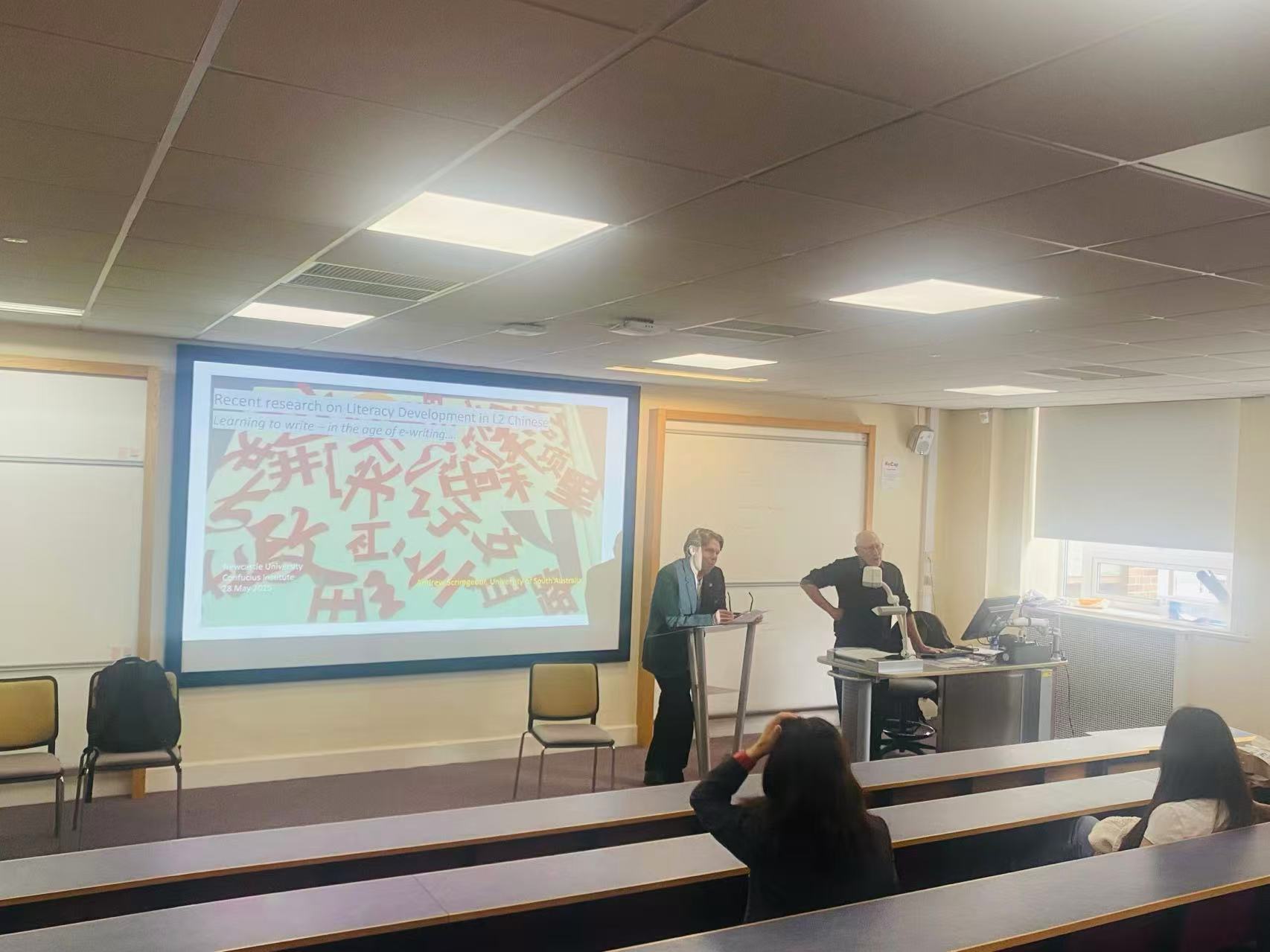Confucius Institute Chinese Academic Lecture at Newcastle University
3 June 2025
On 28 May, the Confucius Institute at Newcastle University hosted an academic lecture at the Percy Building. Dr. Andrew Scrimgeour, a doctoral researcher from the University of South Australia, delivered a thought-provoking talk titled:
“Recent Research on Literacy Development in L2 Chinese: Learning to Write in the Age of E-Writing.”
Curriculum Structure and Challenges
Dr. Scrimgeour began by identifying structural limitations in Australia’s Chinese language education. In countries like Australia and the United States, the teaching of Chinese literacy for second language (L2) learners faces significant challenges. Current curricula are heavily influenced by models developed for English literacy acquisition and fail to account for the distinctive complexity of the Chinese writing system. This mismatch leads to poor learning outcomes and low learner motivation. Dr. Scrimgeour called for a fundamental overhaul of teaching methods to align them with the structural logic of Chinese characters.
He noted that Australia’s 2015 Chinese Curriculum, revised in 2023, adopts a standardized literacy development path across all languages. This model conflates spoken and written language acquisition, assuming both progress at the same rate. However, studies show that Chinese—due to its visual and structural intricacies—poses unique challenges. Unlike alphabetic languages, Chinese learners must acquire thousands of characters, each composed of strokes and components, functioning both phonetically and semantically. By failing to distinguish between spoken and written skills, the curriculum increases cognitive load and hinders learner progress.
Textbook Analysis
Commonly used textbooks such as Jinbu further exacerbate the problem. These materials introduce characters thematically rather than developmentally, causing students to encounter the writing system in a fragmented way without a coherent learning pathway. For instance, HSK Level 1 requires mastery of 300 characters, yet most textbooks cover only half of these, leaving major gaps in learners’ knowledge.
Moreover, character practice often focuses on rote copying with little attention to stroke detail, leading to weak retention and low motivation. Dr. Scrimgeour argued that these materials fail to reflect the hierarchical structure of Chinese characters—from strokes, to components, to full characters. He found that learners’ practice tends to be mechanical, lacking meaningful engagement with character structure.
Learner Experiences and the Handwriting Debate
The debate between handwriting and digital tools adds further complexity. Some educators in the U.S., such as Professor Matt Koss, advocate for e-writing tools to ease the burden of memorizing characters. Critics, however, emphasize that handwriting is vital for developing motor memory and visual recognition.
Dr. Scrimgeour presented student work and analyzed common errors, noting that students often engage in repetitive writing without grasping the underlying structure of the characters. This mechanical approach results in quick forgetting and diminished interest. His classroom observations revealed that excessive repetition can actually worsen writing performance.
Reconceptualizing Literacy Instruction
Dr. Scrimgeour proposed a paradigm shift in Chinese literacy instruction for L2 learners. He advocated for a communication-oriented approach grounded in bottom-up, form-based character cognition. His concrete suggestions included:
- Component-Based Instruction: Deconstruct characters into strokes and components (e.g., radicals and phonetic parts) to reduce cognitive load. For example, the 300 HSK Level 1 characters are made up of 226 components, many of which recur frequently. Teaching these systematically can streamline the learning process.
- Pattern Recognition Training: Help students recognize recurring stroke patterns and component combinations. For instance, grouping characters that share the “扌” (hand radical) creates memory anchors.
- Instructional Clarity: Provide teachers with structured frameworks to explain the writing system clearly and systematically.
- Delayed Literacy Instruction: Some experts suggest introducing character learning only after students have built a solid foundation in spoken Chinese to reduce the simultaneous cognitive demands of speaking and writing.
Future Directions in Chinese Character Instruction
Dr. Scrimgeour introduced innovative methods such as the “Five Views Method”, a component-oriented pedagogy that links prior knowledge with new content through character form and structure. By redesigning the curriculum to reflect the layered progression from strokes to components to full characters, students can gain a more intuitive grasp of the writing system.
He also advocated for the integrated use of digital tools alongside traditional handwriting. While technology offers convenience, he emphasized that pen-and-paper practice remains indispensable for developing fine motor skills and visual memory.
Q&A with Professor Yuxiao Su
During the Q&A session, Professor Yuxiao Su, Chinese Director of the Confucius Institute, raised a key question about how international Chinese language teachers should evaluate the impact of their work, especially given the motivational challenges faced by L2 learners struggling with Chinese characters.
Dr. Scrimgeour responded with two reflections:
- Even if students do not pursue advanced proficiency, the classroom can offer a warm and enjoyable introduction to Chinese, enriching their educational experience.
- Among many, a few learners will persist, overcome the bottlenecks, and develop a deeper passion and competence in Chinese. His own experience—as an L2 learner who succeeded in mastering the language—is itself a source of inspiration for students.
Professor Su found these insights highly enlightening and encouraging.
Dr. Andrew Scrimgeour’s reflections on Chinese character instruction for second-language learners offered fresh insights and thoughtful strategies. As one scholar put it:
“We must bring the language to the learner, rather than bringing the learner to the language.”

